Sieunjae / 시은재
1.1Km 2025-08-13
439, Samil-daero, Jongno-gu, Seoul
+82-10-5355-3029
Located in Gyeongun-dong, Jongno-gu at the very heart of Seoul, Sieunjae is a hanok with a longstanding tradition. It has three guestrooms including the anbang (main room), byeolchae (detached building), and jakeunbang (small room). The anbang is the only room with a living room, where various items of old furniture, including a comfortable sofa, create an antique atmosphere. The communal bathroom and toilets are supplied with toiletries, while the communal kitchen is equipped with cooking equipment and a washing machine.
The house can be rented either as individual accommodations or in its entirety. As it is situated in Jongno-gu, at the very heart of Seoul, guests can easily reach many nearby major tourist attractions. Car users are advised to use the public parking lot as the house has no parking spaces. Entering by a small gate, the little flowerbed comes into sight. This old hanok shows traces of repair works on the tiled roof.
Insa-dong Antique Art Street (인사동 고미술거리)
1.1Km 2025-08-04
29, Insadong-gil, Jongno-gu, Seoul
As of today, there are approximately 70 shops in the Insa-dong area that sell antique arts. Some of the products they sell include antique artworks, porcelains, woodcrafts, and metalwork. Visitors may even find rare and valuable products such as earthenware from the Silla period or white porcelain used in the Joseon dynasty. Each shop is a specialty store, authorized to sell product types that are of their expertise, ranging from antique furniture and traditional artworks to handcrafted items.
Imun Seolnongtang (이문설농탕)
1.2Km 2025-08-08
38-13, Ujeongguk-ro, Jongno-gu, Seoul
Saewha Hostel (세화호스텔)
1.2Km 2025-07-23
50, Samil-daero 32ga-gil, Jongno-gu, Seoul
Museo del Tteok (떡박물관)
1.2Km 2021-07-16
Donhwamun-ro 71, Jongno-gu, Seúl.
En este lugar se encuentran en exposición diferentes utensilios y artículos que se utilizan para preparar el tteok (pastelillos dulces de arroz de distintos sabores y formas); infusiones y licores tradicionales que son ideles para acompañarlos en cualquier ocasión. El tteok es un tipo de postre coreano que presenta miles de variedades y sabores. La receta de cada tipo de tteok es muy científica y sabe exactamente cómo respetar los ingredientes para obtener un resultado sublime en cuanto al sabor, propiedades nutricionales, textura y aroma.
Tienda de Suvenires Coreanos en Insa-dong (한국관광명품점(인사동))
1.2Km 2024-02-19
Insadong 5-gil 14, Jongno-gu, Seúl
Centro de Arte de Seúl Galería Gongpyeong (서울아트센터 공평갤러리)
1.2Km 2023-01-03
Samil-daero 30-gil 10-3, Jongno-gu, Seúl.
Parque Sejongno (세종로공원)
1.2Km 2024-09-10
Sejong-daero 189 (subsuelo), Jongno-gu, Seúl
El Parque Sejongno está localizado cerca del Centro Cultural Sejong de Seúl. Dentro del parque hay bancos de madera y zonas con sombra para que la gente pueda sentarse y relajarse. También hay fuentes de agua, un escenario exterior y varias esculturas. Entre semana, el parque se llena de oficinistas que lo visitan a la hora de la comida, y durante los fines de semana incluso se realizan bodas al aire libre.
Palacio Changgyeonggung (창경궁)
1.2Km 2025-05-13
Changgyeonggung-ro 185, Jongno-gu, Seúl.
El palacio Changgyeonggung de Seúl es uno de los palacios más especiales del período de la dinastía Joseon. El origen de este palacio proviene de la asunción del rey Sejong (1397-1450) en 1418. Una vez que fue coronado, mandó construir el palacio Suganggung para brindarle mayores comodidades al monarca anterior, Taejong (1367-1422), que había abdicado en su favor. El palacio Changgyeonggung fue degradado a Changgyeongwon, sede de jardín zoológico y botánico durante el período de la ocupación japonesa de Corea (1910-1945). En 1983, el zoológico fue trasladado y el palacio fue completamente restaurado volviendo a ser llamado Chaggyeonggung.
Pasando por la entrada principal al palacio, la puerta Honghwamun, se ve el puente Okcheongyo. Todos los palacios de la dinastía Joseon tienen estanques con un puente encima con forma de arco, tal como el puente Okcheongyo. Cruzando Okcheongyo, se pasa por la puerta Myeongjeongmun, y entonces, se halla el pabellón Myeongjeongjeon, que era la oficina del Rey. Además, Myeongjeongjeon es el pabellón más antiguo de su tipo de todos los palacios del período de Joseon. Normalmente, las construcciones de esta época se elevan mirando hacia el sur, pero Myeongjeongjeon mira hacia el este. Esto se debió a que los mausoleos de los anteriores monarcas se encontraban al sur y según las costumbres confucianas, no se permitían tener aperturas hacia la misma dirección. A uno y otro lado del patio se encuentran alineadas las piedras con los grabados que indicaban la jerarquía de los funcionarios oficiales.
Detrás de Myeongjeongjeon, hacia la izquierda y sobre un terreno más elevado se encuentra la sala Sungmundang. Esta sala fue construida aprovechando muy bien la pendiente de la geografía montañosa. Si se observa Myeongjeongjeon y Munjeongjeon, la combinación de las laderas montañosas y la línea de sus techos logran una armonía de gran belleza. Otro pabellón, Tongmyeongjeon, fue construido para la reina. Es la construcción más grande dentro del palacio Changgyeonggung, y en muchos lugares se notan detalles delicados de sus estructuras en atención a la reina. Andando por las rocas de Yanghwajeon después de pasar por Tongmyeongjeon, se llega a Jagyeongjeon. Y hacia el sudeste de Jagyeongjeon se encuentra Punggidae. Punggidae es un instrumento que servía para medir el viento. Se trata de una larga vara con un jirón de tela atada a una punta, y se la usaba para medir la velocidad y dirección del viento.
Dirigiéndose hacia el norte uno se encuentra con un enorme estanque denominado Chundangji. Originalmente, la mitad del estanque era utilizada por el mismo rey para cultivar arroz y aprender sobre agricultura. Pero durante la ocupación japonesa, transformaron el campo de arroz en estanque para hacer flotar pequeños botes sobre él. El jardín botánico creado en aquellos días sobre la parte superior del estanque permanece aún en la actualidad.
Puerta Honghwamun del Palacio Changgyeonggung (창경궁 홍화문)
1.2Km 2025-08-08
Changgyeonggung-ro 185, Jongno-gu, Seúl
Es la puerta instalada en el noreste de la muralla de Seúl, siendo una de las 4 principales. Fue construida en el mes de septiembre del 5º año del rey Taejo (1396), y en aquel momento fue denominada Honghwamun. Pero en el año 1483, al 14º año del reinado de Seongjong, se reconstruyó el palacio Changgyeonggung, pero su puerta oriental también se llamaba Honghwamun, por la que se le cambió el nombre a Hywahwamun en 1511. La puerta fue destruida cuando se abrió una calle para coches durante el período de la ocupación japonesa, en la primera mitad del siglo XX, pero en 1992 fue reconstruida y recuperó su nombre original.
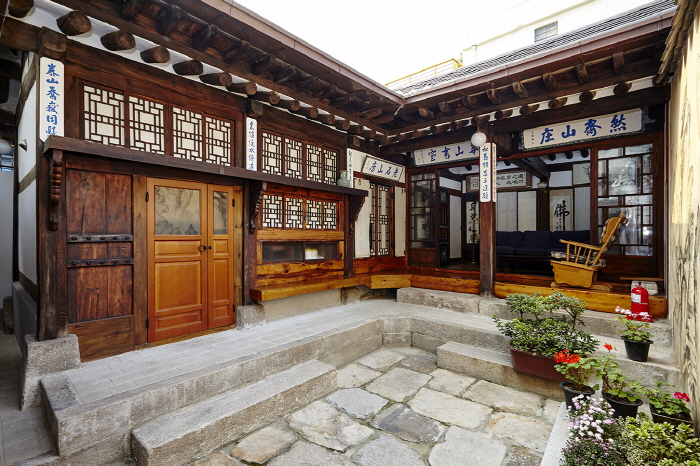
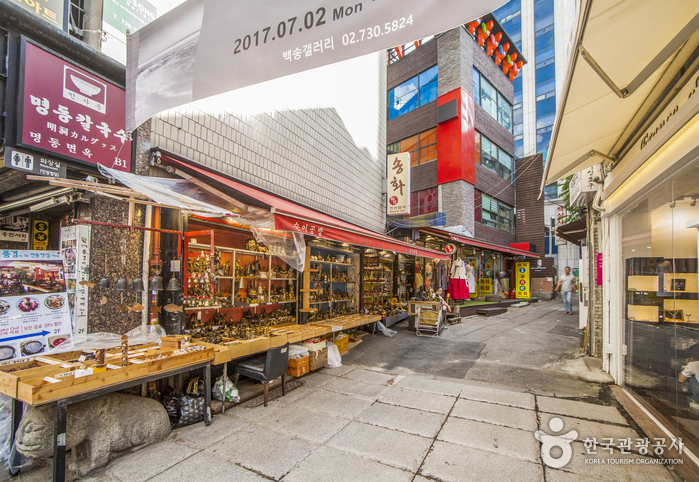

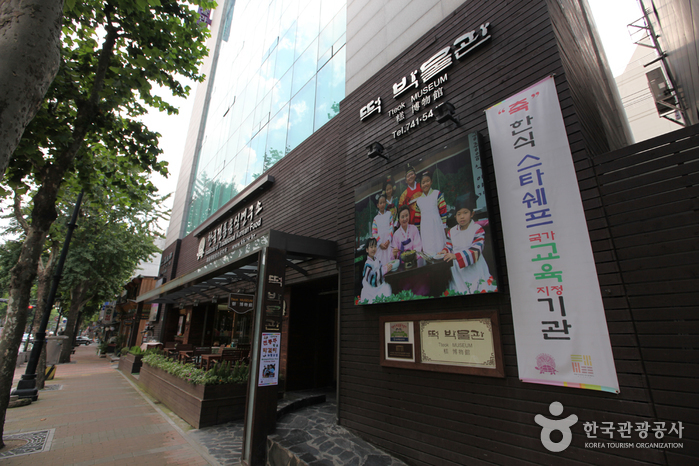
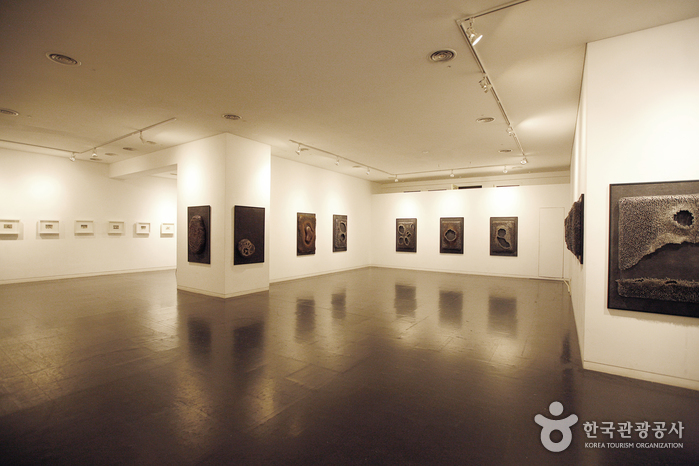
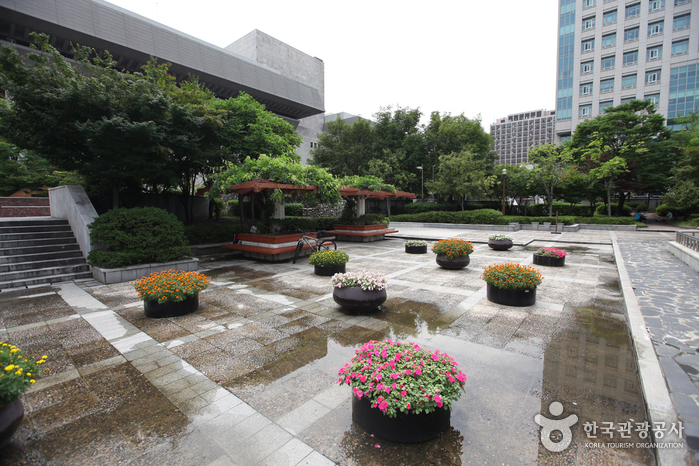
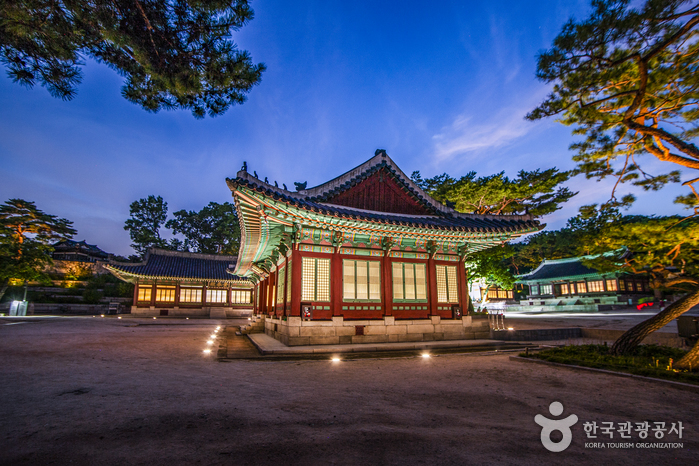
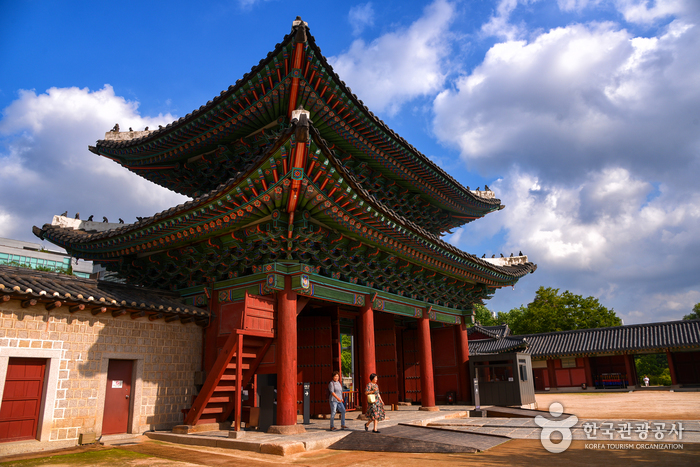
 Español
Español
 한국어
한국어 English
English 日本語
日本語 中文(简体)
中文(简体) Deutsch
Deutsch Français
Français Русский
Русский